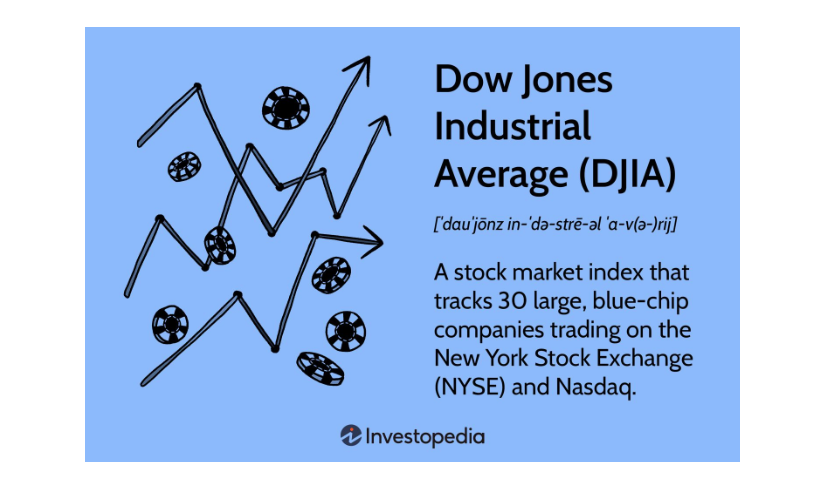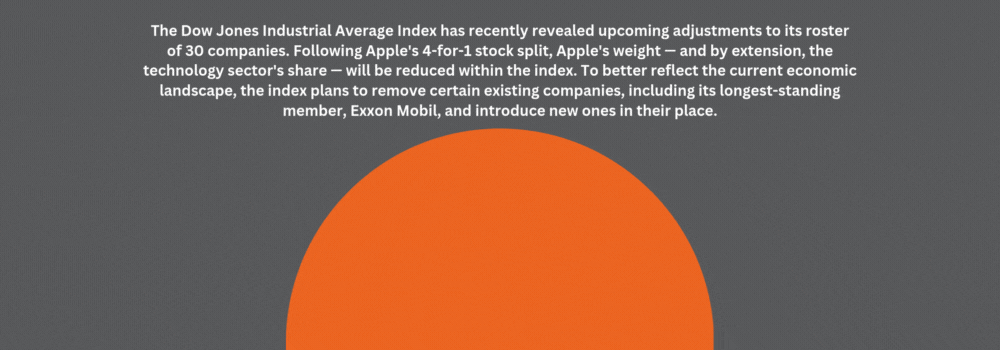What It Means for Investors and the Future of the Dow Jones Industrial Average Index
The Dow Jones Industrial Average (DJIA), or “The Dow,” is a popular and widely-followed stock market index, a core benchmark of investor sentiment and economic health. Understanding this 30-stock index is not static, each Dow Jones update reflects shifts in the U.S. economy, as well as the overall market and investment landscape.
Recently, the Dow has taken a step forward to add an innovative and fast-growing company, attempting to be a more accurate gauge of current market and economic trends.

The DJIA has long acted as a barometer for market sentiment, reflecting the confidence, concerns, and trends driving investor decisions and the overall U.S. economic outlook. Recently, it was announced that Nvidia, a powerhouse in the A.I. and technology industry, will replace Intel in this index. This recent Dow Jones update marks a major shift in the Dow, reflecting the growing influence of AI and semiconductor technologies.

As Nvidia steps into and Intel steps out of the Dow, many investors are left wondering how this change will affect their portfolios. In this article, we are going to analyze The Dow and its historical role in the stock market, and the effect that Nvidia’s inclusion may have on the index.
Key Takeaways
- Nvidia has replaced Intel in the Dow Jones Industrial Average, reflecting the rising influence of AI and semiconductors.
- The Dow regularly updates its lineup to mirror market and economic shifts, helping it stay relevant as a benchmark index.
- Nvidia's inclusion may drive new interest and demand in the stock, possibly impacting its stock value.
- Nvidia’s presence may enhance the Dow’s performance, especially given tech and AI's growing role in the economy.
- This Dow Jones update highlights the importance of emerging tech sectors, potentially attracting new investors.
What is the Dow Jones Industrial Average?
The Dow Jones Industrial Average, first introduced in 1896 by Charles Dow, is one of the oldest and most influential stock market indices. It was created to offer a snapshot of the industrial sector's health by tracking a group of prominent U.S. companies.
Over time, however, the index has evolved, representing a broader host of industries to better reflect the diverse U.S. economy. Today, the Dow consists of 30 leading companies across sectors such as technology, healthcare, finance, and consumer goods.
Unlike other indices that are market capitalization-weighted, the Dow is price-weighted. This means that companies with higher stock prices influence the index more than those with lower prices. For example, a large movement in the price of a high-priced stock, like UnitedHealth or Goldman Sachs, will have a more significant effect on the DJIA than a comparable move in a lower-priced stock.
The index is maintained by S&P Dow Jones Indices, and its components are selected by a committee. Companies are included based on their economic significance, stability, and representation of critical U.S. economic sectors. Importantly, the index is not static; it is periodically reviewed to ensure it accurately reflects shifts in the economy. Companies may be added or removed based on their performance, relevance, and role in the market. This adaptability is essential for maintaining the Dow’s position as an accurate measure of U.S. economic health.
Recent Changes in the Dow
Before Nvidia's addition to the Dow, the most recent rearrangement took place in February, when Amazon replaced Walgreens (WBA). Walgreens had been struggling for some time, and its underperformance led the Dow to seek more exposure to the consumer retail sector.
Prior to that, the Dow made significant changes, removing ExxonMobil, Pfizer, and Raytheon Technologies (formerly Raytheon) in favor of Salesforce, Amgen, and Honeywell in 2020. These new additions have generally outperformed the broader market, with the notable exception of Exxon, whose stock struggled due to the pandemic’s impact on oil prices.

These shifts in the DJIA index underscore the Dow’s role in adapting to changing industries and economic forces. Companies are regularly removed when they no longer are deemed a “good” representation of the current market landscape, with many of them seeing initial declines in their stock prices after being ousted.
Nvidia Joins the Dow
The decision to add Nvidia, a leader in graphics processing units (GPUs), artificial intelligence, and data processing, reflects the tech sector's rapid evolution and the shift towards AI-driven industries.
Nvidia has been instrumental in powering industries from gaming to machine learning, and its advanced chips are the foundation of AI innovation. The company’s relevance to the modern economy — and the tech sector’s future — made it an ideal addition to the Dow.
Notably, this switch is more symbolic than material, as the Dow is just one index that is used to measure the health and success of the market. As Nvidia joins the Dow Jones Index's current lineup, its presence signals the stock market's commitment to AI, automation, and digital innovation, influencing both Nvidia stock forecasts and investor interest in the tech sector. Investors are likely to view this change as a signal that these areas continue to be central to U.S. economic growth, and that the companies behind them may be among the strongest players in the market.
As Nvidia enters the DJIA index, investors might want to watch Nvidia's stock forecast closely, assessing its growth potential in AI-driven sectors.
Nvidia’s Background and Historical Stock Performance
Founded in 1993, Nvidia (NVDA) started as a gaming chip manufacturer but quickly evolved into a leader in high-performance computing. Its GPUs became essential to gaming, but Nvidia soon saw the potential for its technology to drive other innovative industries, including data centers, AI, and autonomous vehicles.
NVDA’s growth has been fueled by its focus on research and development (R&D), and the development of powerful, versatile chips. Nvidia’s stock performance also reflects this growth. Over the past decade, Nvidia’s shares have risen dramatically, driven by strong revenue and earnings growth, driven by increasing demand for its technology. Nvidia’s stock grew by 239% in 2023 alone!
Nvidia is also part of the “Magnificent 7” group of stocks, a group of tech giants driving much of the S&P 500’s gains in recent years. Its inclusion with these Magnificent 7 stocks showcases Nvidia’s standing among the elite companies shaping the future of technology.
Intel’s Role in the Dow
Intel (INTC), a pioneering force in computer processors, was added to the Dow in 1999, during a time when personal computing was rapidly expanding.
Intel played a central role in the growth of personal computing and the Internet, and its processors became recognized for high-quality computing power. However, in recent years, Intel has struggled with competition and shifting demands. While it remains a leader in the semiconductor industry, Intel has faced pressure from companies like AMD and Nvidia, especially in high-performance computing and AI applications.
The decision to remove Intel from the Dow is largely due to its recent struggles to keep up with industry changes. Although Intel still has a significant market share, its slower adoption of new technologies and recent challenges have diminished its appeal, compared to Nvidia, whose growth trajectory and market leadership align it better with the Dow’s representation of industry leaders.
Implications for the Dow and Investors
Thinking about investing in Nvidia? Here’s what you should know.
Nvidia’s addition to the Dow is a strong statement about the prominence of AI and data processing in the modern economy. Nvidia brings a fresh, high-growth tech component to the Dow that Intel, despite its achievements, could no longer offer. This shift also highlights the broader trend of high-tech, AI-driven industries becoming more integral to the U.S. economy.
As the Dow’s current lineup becomes increasingly tech-centric, Nvidia's stock forecast will be of interest to investors looking for AI-driven growth.
For Nvidia investors, this Dow Jones update serves as an endorsement of the company's AI-driven growth potential, with many closely watching Nvidia stock forecasts to forecast future performance. Nvidia’s stock could see increased demand due to the index’s broader market exposure, potentially driving up its price further as institutional investors who track the Dow may begin to allocate more capital to Nvidia.
For new investors, Nvidia's inclusion could signal a strategic opportunity. As a tech leader and a key player in the future of AI, the stock offers long-term growth potential. However, it’s essential to keep in mind that Nvidia’s price may already reflect much of this growth, meaning any short-term gains could be tempered by market fluctuations.
Before allocating investments in response to this event, investors should consider whether Nvidia fits within their long-term portfolio goals, especially since tech stocks are often more volatile than those in other sectors.
The Dow itself stands to benefit from Nvidia’s inclusion. As a leader in the semiconductor industry and a key player in the AI sector, Nvidia represents the growing influence of technology on the broader economy. The inclusion of such a forward-looking company emphasizes the Dow’s adaptability and commitment to staying relevant in the face of rapidly changing market and economic trends. This shift may also attract more interest from investors focused on technology and innovation, potentially increasing the overall performance of the index over time.
Ultimately, as with any major market change, it’s important for you, as an investor, to consult with your financial advisor before making any decisions about adjusting your portfolio. While Nvidia’s inclusion in the Dow is an exciting development for tech and AI enthusiasts, every investment decision should align with your longer-term financial goals, risk tolerance, and investment strategy.
Working with an advisor can provide valuable insights into how such changes may impact your portfolio and help you navigate market trends effectively.
Final Thoughts
As Nvidia replaced Intel in the index, the growing importance of sectors like AI and semiconductors is becoming much more apparent to investors.
This shift in the Dow Jones index's current lineup highlights the Dow’s adaptability to economic trends and could shape future Nvidia stock forecasts, reinforcing the index’s role as a vital measure of market sentiment and the U.S. economy. For Nvidia investors, this inclusion could increase stock demand, while new investors may see it as a long-term growth opportunity.
If you’re considering making significant changes to your portfolio following this news, we recommend that you meet and consult with a trusted financial advisor. Each decision that you make should be in line with your preferences, goals, and time horizon — NOT as a knee-jerk reaction to recent trends in the market.
At Towerpoint Wealth, a Sacramento Investment Advisor Firm, we work intimately with our clients to create a disciplined plan and strategy that aligns with their shorter and longer-term personal and economic goals. If you want to talk with an experienced advisor to decide if you should adjust your investment strategy, we welcome speaking with you.
Investing in individual stocks involves significant risks that investors should carefully consider. These risks include, but are not limited to: Market Volatility: The value of individual stocks can fluctuate widely due to market conditions, economic events, geopolitical developments, or company-specific news. Business-Specific Risk: Individual companies face unique risks such as declining revenues, management changes, operational challenges, or financial instability. Poor performance or bankruptcy of a company could result in a total loss of your investment. Concentration Risk: Investing in a single stock or a small number of stocks increases exposure to the risks of those particular companies, reducing diversification benefits and potentially amplifying losses. Lack of Liquidity: Some stocks, especially smaller-cap or less-traded ones, may have low liquidity, making it difficult to buy or sell shares at a desired price. Time Commitment: Properly researching and monitoring individual stocks requires time, effort, and expertise to stay informed about the company's performance, industry trends, and market conditions. Unpredictable Events:
Natural disasters, regulatory changes, litigation, or unforeseen crises can adversely affect individual stocks, regardless of their previous performance. Emotional Decision-Making: Investors may react emotionally to short-term market fluctuations, leading to poor decisions such as panic-selling or overbuying.
Important Reminder: Past performance of a stock is not indicative of future results. Investing in individual stocks carries no guarantees, and investors should be prepared for the possibility of losing some or all of their principal investment.
Recommendation: Diversification and consultation with a qualified financial advisor can help mitigate these risks. Ensure any investment decisions align with your financial goals, risk tolerance, and time horizon.
This newsletter is for informational purposes only and should not be construed as personalized investment advice.
Joseph Eschleman, CIMA®
President
Jonathan W. LaTurner
Partner, Wealth Advisor
Steve Pitchford, CPA, CFP®
Director of Tax and Financial Planning
Lori A. Heppner
Director of Operations
Nathan P. Billigmeier
Director of Research and Analytics
Michelle Venezia
Client Service Specialist
Luis Barrera
Marketing Specialist
Megan M. Miller, EA
Associate Wealth Advisor
Isabelle Orozco
Office Coordinator
Connect with Towerpoint Wealth, your Sacramento Financial Advisor, on any of these platforms, and send us a message to share your preferred charity.
We will happily donate $10 to it!
Follow TPW on LinkedIn
Follow TPW on YouTube
Follow TPW on Facebook
Follow TPW on Instagram
Follow TPW on X
Follow TPW Podcast










